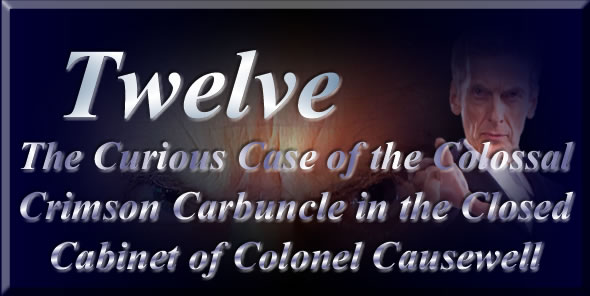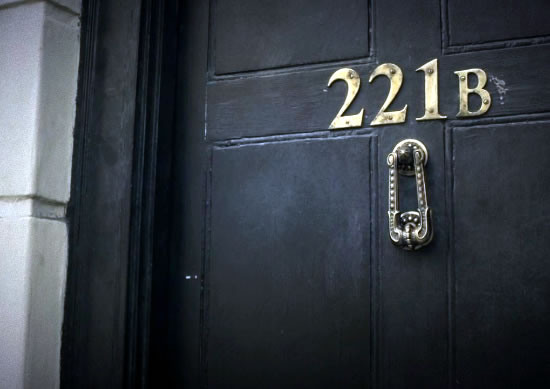

Marie Reynolds followed The Doctor up the narrow but scrupulously clean staircase to the first landing of the residential building. There, the housekeeper announced them to the sole occupant of the large and well lived-in drawing room.
"Doctor, old friend, your timing is providential," declared the tall, imposing man in a deep red velvet Victorian smoking jacket who rose to greet them. "Come and sit at the fireside. Help yourself to a cigar and the port. Mary, the tea table by the window is the one touch of feminine comfort in this confirmed bachelor's home. The Earl Grey should be perfectly brewed by this coincidental moment and Mrs Hudson has provided some dainty sandwiches with the sort of thin fillings refined women prefer."
Marie was on the point of correcting the impossible man on her name, but she caught the barely imperceptible glance from The Doctor that she had quickly learnt to read volumes into. She accepted for the moment that her name was Mary and sat at the dainty table covered in a crisp tablecloth and furnished with delicate bone china. She poured a cup of tea and watched The Doctor and the one man who might be his equal smoking cigars, drinking port and discussing the very intriguing case of Colonel Causewell’s carbuncle.
This, of course, was a large gemstone, not a nasty boil on the Colonel’s person.
Marie’s senses reeled. It was all completely bewildering. The Doctor had told her that he was introducing her to a group of friends who lived in London in the late Victorian era. She had dressed accordingly. The amazing room he called The Wardrobe provided the dress. It was dark blue taffeta and fitted her like a glove. She almost felt Victorian in it.
But when they stepped out of the TARDIS they were not in Paternoster Row in the lee of St. Paul's Cathedral on a typically foggy morning in which the dome of the great building would float out from the sea of white like a great vessel.
Before The Doctor had drawn breath to say that something was amiss the front door of the property beside which the TARDIS stood was opened. They were greeted by the housekeeper who said that they were expected and ushered them up the seventeen stairs to the drawing room where they now were.
Marie sipped her tea and looked out of the window overlooking a busy London street.
It was busy with pedestrians walking in all directions with all sorts of errands or business to conduct, carrying umbrellas, carrying brown paper parcels, pushing perambulators. She saw all sorts of horse drawn traffic, too. She saw a dray pulled by two huge shire horses. There were lots of small black hansom cabs pulled by single horses. They moved swiftly, easily passing the larger vehicles, mostly open or closed types of two-horse carriages, some obviously very expensive. Words like landau and brougham floated in her mind but she wasn't expert enough on the subject of horse drawn carriages to know which was which.
She had seen pictures of this same street in the twenty first century. It thronged with vans, buses, taxis and private cars as well as hundreds of pedestrians, often with umbrellas and parcels as well as perambulators and other encumbrances.
The more things change, the more they stay the same.
But that was true of any city street. The thing that bothered her was that this was Baker Street.
Which was a real street, in the Marylebone district of London.
But this building - a comfortable Georgian town house – shouldn’t be there.
She knew as much from a magazine article she had read in the school staff room only a couple of days ago. The article had looked at real addresses in fiction, mentioning among other places the house in Clanbrassil Street, Dublin, where Leopold Bloom was fictionally born, Richard Hannay's flat in Portland Place and the Savile Row home of Phileas Fogg.
All three of those real addresses had official plaques celebrating their literary connections. Marie could confirm the first example. The Tallaght bus was frequently halted by traffic lights right outside the otherwise unpretentious building. She had read the plaque so often it was seared on her memory.
221b Baker Street didn't have such a literary marker. Unlike those other buildings, it didn’t really exist. When Conan Doyle wrote his Sherlock Holmes stories for The Strand Magazine the house numbers didn't go up that far. The author was trying to spare a real resident from nuisance callers. In the 1930s an office block was built for what would become the Abbey National Building Society and was given the address 221 Baker Street. The company actually engaged a secretary to reply to the fan mail that began legitimately arriving at an address that existed after the fact. Later still, a Sherlock Holmes Museum was granted the postal address even though it was out of sequence with all the other numbers.
That meant that she was drinking tea in a fictional house while The Doctor was talking to its equally fictional tenant.
Which begged a question.
Actually, it begged several questions. Marie looked for a long moment at the delicately cut triangle of smoked salmon sandwich and wondered if fictional food contained calories.
She ate it, noting that fictional food had a taste, at least, and listened to the two men by the fire talking about various ways that the Crimson Carbuncle, a notoriously large, conspicuous jewel could be smuggled out of a locked room.
"Of course, locked rooms are most often nothing of the sort," The Doctor pointed out. "If a man rattles a knob dramatically and cries out that the door is locked, who will disbelieve him? He can send any witnesses running after keys or battering rams while he slips into the room, steals the goods, THEN locks the door and is waiting patiently when the witnesses return to finally force open the said locked door."
Marie decided that he must have deliberately chosen to ‘rattle a knob’ rather than just turn a handle just to get a cheap laugh. She ignored that accordingly.
The Doctor sat back in his seat just a little too smugly after delivering his scenario. Far too smugly. It wasn’t as if it was anything he had worked out for himself. Marie could think of three variations on the same theme that had featured on television detective dramas broadcast in the past week.
"Indeed," Holmes agreed. "And I have come across tricks of the very sort more than once in my career. Most notably The Affair of the Dead Parrot. But on this occasion, I can vouch absolutely for the man who raised the alarm. He is above suspicion."
"And the name of this unimpeachable man is...." The Doctor led, taking a large drag on the cigar and savouring the taste far too much for a man who had claimed to be a non-smoker when Marie came aboard the TARDIS.
"It is I," Holmes answered triumphantly. "I, myself, am the very man who accompanied the clerk, John Clancy of Southall, who had the master key in his possession. I can assure you that the door was, indeed, locked."
"That utterly rules out such a devious trick," The Doctor observed. "The room had solid walls, windows secured, no trapdoors or skylights, no secret panels?"
"None whatsoever," Holmes answered. "The room was as secure as a vault in The Bank of England."
Marie half expected him to say that it WAS a vault in the Bank of England, Holmes went on to explain that the gem was in fact contained within a miniature cabinet made of hand tooled jade. The cabinet was placed in a safety deposit box which was in the vault of the Lloyds Bank just a short walk away on Baker Street itself.
Marie looked at The Doctor as he listened to Holmes and occasionally asked questions which tested small details of the story but really didn't advance it all that much.
It was just like a Sherlock Holmes story in so many respects it was almost boringly predictable. The Doctor had slid into the role of the detective's intellectual foil, Doctor Watson, asking these barbed questions every so often that made Holmes feel important.
Which was fine apart from a couple of little points that niggled in Marie's thoughts.
First, she was sure The Doctor was head and shoulders more intelligent than Sherlock Holmes, and could run rings around him on any puzzle. The brief time she had spent with him was enough to convince her that he was by far the smartest of the two.
Which was at odds with the position of Watson who was, while a clever man, always portrayed as quite ordinary compared to Holmes.
She was also concerned with the idea that her role here was as Mary Watson, the good Doctor's wife.
She didn't know HER Doctor anywhere near well enough for that, yet.
Holmes was still talking. He had described at length the walk from 221b Baker Street to the Lloyds bank on the junction of that same street and Marylebone Street. He described in equal detail the public area of the bank and the way down from there to the vaults. He continued by explaining how the gem was placed in the vault of that impregnable fortress.
"It is the Russian doll of gems," The Doctor remarked dryly. "Within a cabinet within the safety deposit box within the bank vault. And yet, when vault, box and cabinet were opened, the gem was gone."
"Exactly so," Holmes declared. "Gone from within its safe resting place which cannot be opened except by me. It is my own safety deposit box. This is the key to the box."
Holmes held up a small brass key that was concealed in his waistcoat pocket. "It is kept on my person at all times... except for bathing, of course. But as that activity takes place in my own bathroom with no other soul in the house than the utterly blameless Mrs Hudson there is no question of theft or forgery. The cabinet is opened by an even smaller key that is kept in an unmarked envelope in my bureau, here. There is nothing to indicate the purpose of this key or to connect it with the safety deposit box key. It has been kept in that drawer for the past two years, since the gem was placed in the cabinet, then locked in the safety deposit box in the bank vault."
"On behalf of this Colonel Causewell who had entrusted you with its care," The Doctor surmised.
"Indeed, yes. The Colonel had acquired the gem during a visit to northern India. It was conferred upon him by the Maharajah of Ajinda province as thanks for a personal service rendered.”
Marie made a mental note to find out if there was – or ever had been - any such place as soon as she had access to Google Maps.
“The Colonel vowed never to sell or otherwise relinquish ownership of the gem. Two years ago, however, he offered it as collateral on a loan for a friend who needed capital for a business transaction. The terms were that the gem should be placed in the bank vault, I acting as the third party, holding the gem in escrow until either the principal sum and interest borrowed against it is repaid or in the case of default, the gem should be CLAIMED in compensation by the lender. "
"And one of those circumstances has arisen?"
"It has, though which circumstance need not signify here, only that, when I went to retrieve the gem to fulfil my own role in the transaction, it was gone. The cabinet was within the safety deposit box, but the gem was gone from it."
"Very odd, The Doctor commented. "There were no other items missing from either the specific security box or any other box within the vault?”
This set Holmes off again. Marie sighed wearily and poured another cup of tea. She wondered if The Doctor would mind if she went back to the TARDIS.
Frankly she was bored. This was the problem with most of the Sherlock Holmes short stories. The longer ones like The Sign of the Four or The Hound of the Baskervilles were fine. They had a bit of action and a change of scenery. But a lot of the short stories were just Holmes and Watson sitting by the fire with pipes and port talking about a recently solved case in a smug and self-congratulatory way.
She must have actually dozed off listening to them talk. Suddenly, Marie shook her head and sat back in her chair. She was holding her tea cup in a shaky hand mid way to her lips. She set it down on the saucer quickly, slopping some of the liquid over her hand. She was trembling as if she had just woken up from a nightmare.
But the sun was shining down on Baker Street. Life was passing by as usual and here in the drawing room of 221b Holmes was still explaining in infinitely annoying detail how it was quite impossible for the gem to have disappeared from the vault of that marvellously safe and reliable bank.
Marie giggled as she recalled something else from that magazine article about fictional addresses. A side panel had detailed a real life robbery in 1971 – involving that very same bank vault. The writer had wondered if Sherlock Holmes might have foiled such a plot if he had been around at the same time.
"Marie!"
She was surprised to hear a female voice calling her. She looked around but there was nobody there. The only woman in the house was Mrs Hudson, anyway, and she had kept on calling her Mary.
"We've almost made contact," said another female voice. "Marie, listen to me. Listen very carefully...."
Marie shook her head again. This was weird. She thought she had seen the two women... well, seen something, anyway… leaning over her.
Then she was wide awake in the drawing room again.
"I think I might go for a little stroll," she announced, standing up. It is such a nice afternoon."
"I don't think that is a good idea, Mary," Holmes told her. "You really ought to stay there until we're done."
"No," Marie insisted. "I want to go out, and I don't think you have the right to stop me."
She stood determinedly and went to the door they had come through from the landing. She was startled to find that there was no door. At least there was a door, but no doorway. It opened onto a blank wall.
"Marie, faint, now," said the woman's voice in her ear.
The Doctor was coming towards her, speaking softly, kindly.
But he was calling her Mary. He was a part of it all.
The strange woman wasn't speaking softly. She was ordering her to do something in a thoroughly bossy manner.
But she called her Marie.
She fainted.
While The Doctor and Holmes tried to revive her from a faint worthy of an Abbey Theatre production of a classic Victorian farce, Marie had a thoroughly revealing conversation with a lizard lady and her wife. When she understood everything, she let herself come around in The Doctor’s reassuring arms.
"I'm quite all right, now," she said as she was lifted her to her feet and brought back to the table by the window.
"In fact, I am ready to solve the case of the big red marble."
“You mean the crimson carbuncle?” The Doctor queried.
“Same difference,” Marie insisted.
"You have solved the case?" Holmes exclaimed with more incredulity than was necessary, let alone polite. Bad enough he thought he was the only one capable of deductive reasoning, but the emphasis in the ‘you’ suggested that a woman was even less likely than a well-educated man to come up with an answer.
"Mary, dear, this is hardly a matter I expect you to involve yourself in," The Doctor tried to say before Marie brought the heel of her dainty Victorian shoe down on his instep.
"Later, you and I will be having a bit of a chat about sexual equality," she added. “And when I say ‘a bit’ remember I’m from Dublin. It won’t FEEL like a bit.”
“Marie...."
He disguised the pain well, it had to be said, but the effect was only temporary. He sank back into the illusion again.
He had remembered her name for those few moments, at least. There was hope, yet.
"I know where the big red marble is," she repeated. "And by logical conclusion, why and by whom it was taken."
"I.... think we should indulge her," The Doctor said. "She might become hysterical again."
"I'll give you hysterical." Marie answered, but signs of female emancipation only worried Holmes and she wanted him calm and unsuspecting of her next move.
“Clearly, the gem was not stolen from the marvellously safe place within the bank vault,” she said as the two men sat down again at the fire. “Well, not clearly at all. There is every possibility that a dishonest clerk might have taken the thing, though it would have been quite stupid since a rock that size could hardly be sold without questions being asked. But, anyway, the obvious answer is that it was never there in the first place.”
The two men looked startled. Both began to contradict her, but she hushed them with a mere finger in the air that commanded their attention.
It worked in the classroom. It would work with The Doctor and his chums, too.
“The gem was concealed in this very room by a clever bit of sleight of hand as it was allegedly being put into the jade cabinet. The empty cabinet was put into the safety deposit vault and nobody was any the wiser.”
“But….” The Doctor began.
“I’m not finished,” Marie told him. “You see, it was when you were talking about the gem being like a Russian doll that the solution came to me. The gem had been hidden just as cleverly but in another place entirely.”
As she spoke she took off the knitted tea cosy that was over the pot. She lifted the lid of the pot and inserted a huge silver spoon. After a certain amount of jiggling she found what she was looking for.
“One big red marble,” she announced as she held up the glistening jewel like a misshaped entry into an egg and spoon race. “It’s impressive enough, I must say, but I still think it would be hard work trying to sell it on the black market.”
“But that’s impossible,” The Doctor protested. “It would mean that… that….”
He turned to Sherlock Holmes accusingly.
“YOU are the thief.”
“Now we’re getting somewhere,” Marie told him. “Madam Vastra said finding the gem would start to bring you to your senses.”
“Madam Vastra? She told you….”
“She tried to contact you, but you were mixed up too far in the whole thing. I was easier to reach because I was never completely sucked in. I knew there was something wrong. I knew that 221b Baker Street didn’t exist. I read about it last week. The branch of Lloyds where the gem was meant to be concealed didn’t exist either in Victorian times. It’s a nineteen twenties building, all art deco like a Hercule Poirot murder scene. Madam and Jenny worked on me through those chinks. They told me to reveal the gem and the whole thing would fall apart.”
“Holmes would never steal anything,” The Doctor murmured. “He is above such petty acts.”
“Of course not,” Marie agreed. “Because he’s fictional. A real person might just be tempted. Real people aren’t that perfect. But a fictional clever clogs like Holmes with his fictional morality never would.”
“Of course,” The Doctor agreed. “Marie, you are a very clever young woman.”
“You and I are still going to be having words later about certain things,” she responded.
But it WAS all right now. They were no longer in that fictional drawing room in Baker Street. Holmes wasn’t there. He had never existed, after all. Instead, they were seated at an elegantly polished tea table in the Paternoster Row drawing room of Madam Vastra, a lady often assumed to be foreign, but who actually had a greater claim to be a Londoner than anyone living in the city before or since.
“It was a fiction bug,” Jenny explained as she poured tea for everyone. Marie was going to refuse. She felt like she had been drinking tea for hours, but that tea had been fictional. This was real and tasted far better.
She looked at The Doctor for further explanation.
“They’re rare creatures,” he said. “We were extremely unlucky to be infected on that stop off in The Great Bookshop of Berrundia X. They do try to keep the books sterile, but sometimes one or two larvae tuck themselves into a flyleaf and attach to the unsuspecting reader.”
Madam Vastra held up a small, sealed phial which contained two ugly looking creatures Marie’s imagination didn’t want to describe. She had a slight earache and didn’t need to ask how her fiction bug had been finally evacuated from her brain.
“So, they knocked us unconscious and we had a weird sort of dream where we were characters in a Sherlock Holmes tale,” Marie guessed.
“It happened after you had set off to visit me,” Madam Vastra explained. “The TARDIS landed automatically with you both lying senseless on the floor of the console room. Of course, Jenny and I rendered assistance at once, but a fiction bug has to be handled carefully. The Doctor was very badly affected, being a man, of course. You, Marie, did beautifully. You never did let go of reality. You knew none of it could be real.”
“It couldn’t be. There was never any such place as 221b Baker Street.”
“Exactly. The disbelief, the refusal to fully engage, was all you needed to make the bug let go of you. Then by solving the crime and implicating Holmes in it, something quite out of character for him, you let The Doctor see the truth.”
“Remember that in future,” Marie told him. “Big Time Lord’s brain all confused – little Irish woman’s brain works it out.”
“Brains in humanoid species are generally the same size,” The Doctor pointed out. “That has nothing to do with it. The bug was particularly well fixed to my cerebral cortex, causing the fiction to be thoroughly embedded.”
“As I said,” Madam Vastra added calmly as she passed around a sandwich tray and Marie decided that they were far better than fictional food. “He is a man, and therefore more easily affected.”
“It had all the elements of a Holmes story, though,” Jenny suggested before a battle of wills broke out across the tea table. “A mystery to unravel and everything. ‘The Case of the Crimson Carbuncle.’ Or ‘The Curious Case of the Crimson Carbuncle’. Or….”
Madam Vastra added her own suggestion with a genteel smile of one who didn’t usually play such games but was allowing the indulgence for once.
“The Curious Case of the Colossal Crimson Carbuncle in the Closed Cabinet of Colonel Causewell,” The Doctor concluded as if he was having the last word.
“The Red Marble,” Marie said, proving that the last word was, in fact, hers. “Don’t argue about literature with a woman who’s been stuck in traffic on Clanbrassil Street as often as I have.”

 |
 |
 |